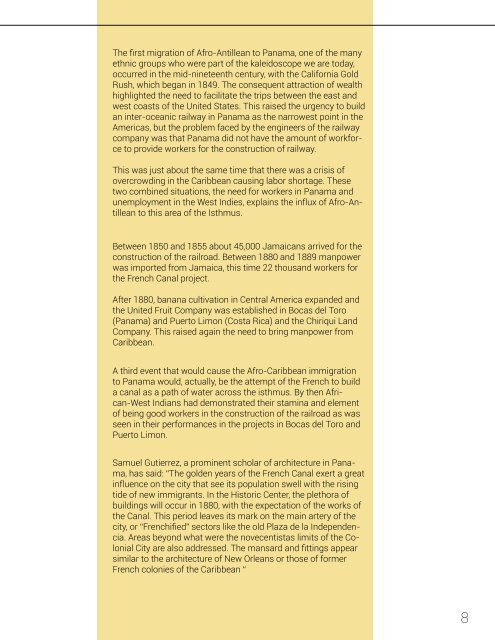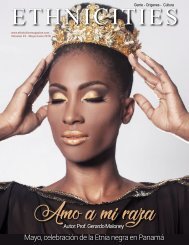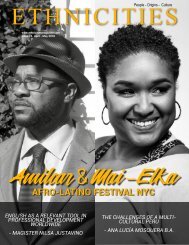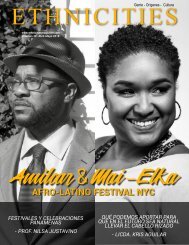Volume 4 - Ethnicities Magazine - October
Create successful ePaper yourself
Turn your PDF publications into a flip-book with our unique Google optimized e-Paper software.
The first migration of Afro-Antillean to Panama, one of the many<br />
ethnic groups who were part of the kaleidoscope we are today,<br />
occurred in the mid-nineteenth century, with the California Gold<br />
Rush, which began in 1849. The consequent attraction of wealth<br />
highlighted the need to facilitate the trips between the east and<br />
west coasts of the United States. This raised the urgency to build<br />
an inter-oceanic railway in Panama as the narrowest point in the<br />
Americas, but the problem faced by the engineers of the railway<br />
company was that Panama did not have the amount of workforce<br />
to provide workers for the construction of railway.<br />
This was just about the same time that there was a crisis of<br />
overcrowding in the Caribbean causing labor shortage. These<br />
two combined situations, the need for workers in Panama and<br />
unemployment in the West Indies, explains the influx of Afro-Antillean<br />
to this area of the Isthmus.<br />
Between 1850 and 1855 about 45,000 Jamaicans arrived for the<br />
construction of the railroad. Between 1880 and 1889 manpower<br />
was imported from Jamaica, this time 22 thousand workers for<br />
the French Canal project.<br />
After 1880, banana cultivation in Central America expanded and<br />
the United Fruit Company was established in Bocas del Toro<br />
(Panama) and Puerto Limon (Costa Rica) and the Chiriqui Land<br />
Company. This raised again the need to bring manpower from<br />
Caribbean.<br />
A third event that would cause the Afro-Caribbean immigration<br />
to Panama would, actually, be the attempt of the French to build<br />
a canal as a path of water across the isthmus. By then African-West<br />
Indians had demonstrated their stamina and element<br />
of being good workers in the construction of the railroad as was<br />
seen in their performances in the projects in Bocas del Toro and<br />
Puerto Limon.<br />
Samuel Gutierrez, a prominent scholar of architecture in Panama,<br />
has said: “The golden years of the French Canal exert a great<br />
influence on the city that see its population swell with the rising<br />
tide of new immigrants. In the Historic Center, the plethora of<br />
buildings will occur in 1880, with the expectation of the works of<br />
the Canal. This period leaves its mark on the main artery of the<br />
city, or “Frenchified” sectors like the old Plaza de la Independencia.<br />
Areas beyond what were the novecentistas limits of the Colonial<br />
City are also addressed. The mansard and fittings appear<br />
similar to the architecture of New Orleans or those of former<br />
French colonies of the Caribbean “<br />
8

















